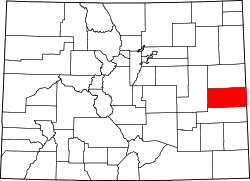

The 64 counties of the U.S. State of Colorado.
The U.S. State of Colorado is divided into 64 counties. [1] Two of these, the City and County of Denver, which serves as the state capital, and the City and County of Broomfield, have consolidated city and county governments. In addition to Denver and Broomfield, Pitkin County and Weld County operate as home rule counties with their own county charters. [2] The other 60 counties operate under state regulations per Dillon's Rule. Counties are important units of government in Colorado since there are no civil townships or other minor civil divisions.
Contents
- History
- Colorado counties
- County population
- Former counties
- County high points
- County mean elevation
- County firsts
- County distinctions
- Gallery
- See also
- Notes
- References
- Further reading
- External links
The United States Census Bureau estimates that El Paso County remains the most populous county in Colorado with a population estimate of 752,772, as of July 1, 2024, while Hinsdale County with a population of 747 is now the least populous. [a] Five of the 64 Colorado counties now have more than 500,000 residents, while 12 counties have fewer than 5,000 residents. [a]
Las Animas County, 4,776 square miles (12,369 km2) in area, is the most extensive county, while the City and County of Broomfield, 34 square miles (87 km2) in area, is the least extensive. The City and County of Denver was the most densely populated Colorado county, with a 2024 population density of 4,918 residents per square mile of land area (1,899/km2), while Hinsdale County was the least densely populated county, with a 2024 population density of 0.67 resident per square mile of land area (0.26/km2).
Mount Elbert, the highest summit of Colorado and the entire Rocky Mountains at an elevation of 14,440 feet (4,401.2 m), is located in Lake County. The lowest point in Colorado is where the Arikaree River flows out of Yuma County and into Kansas, at 3,317 feet (1,011 m) elevation. [b] This point, which is the highest low point of any state, is higher than the highest points of 18 states and the District of Columbia. [4]









































































